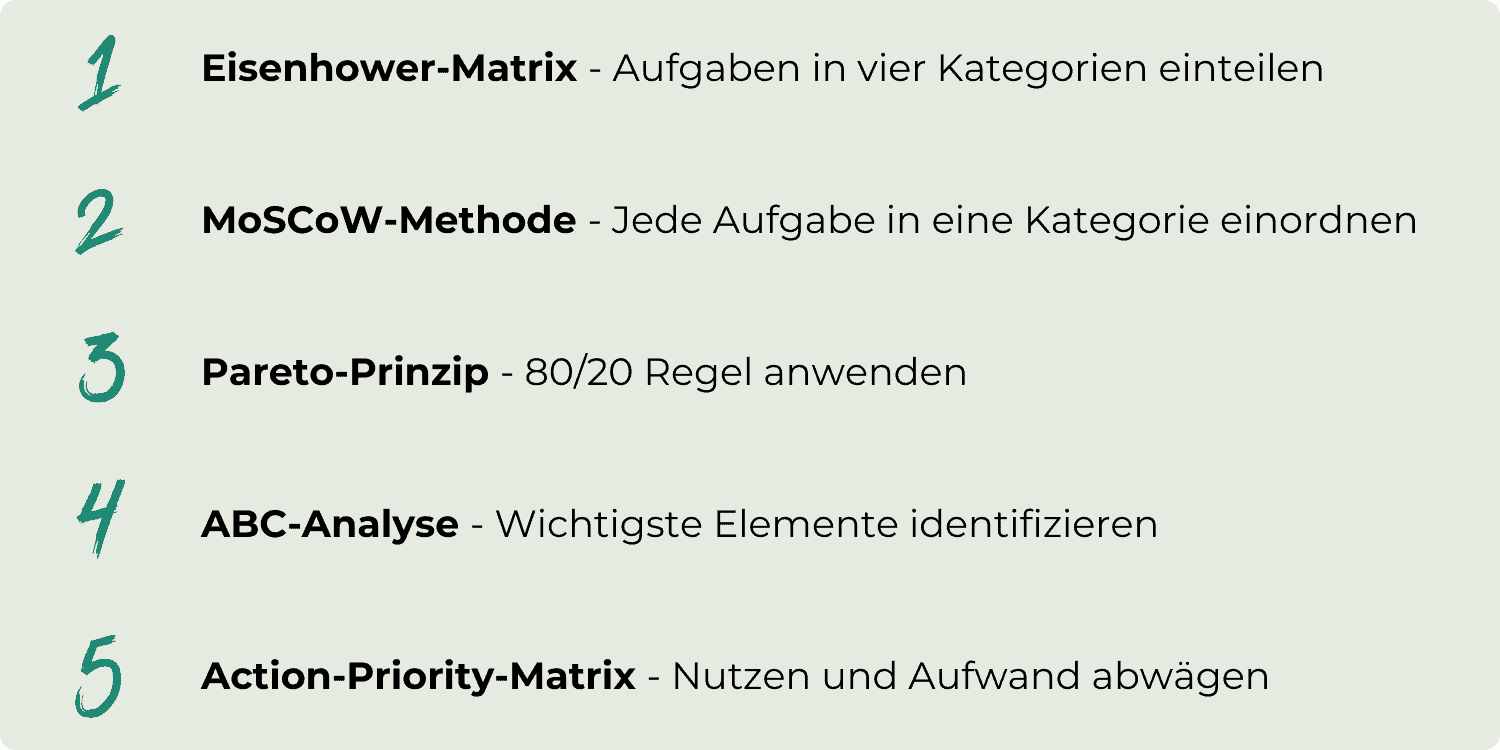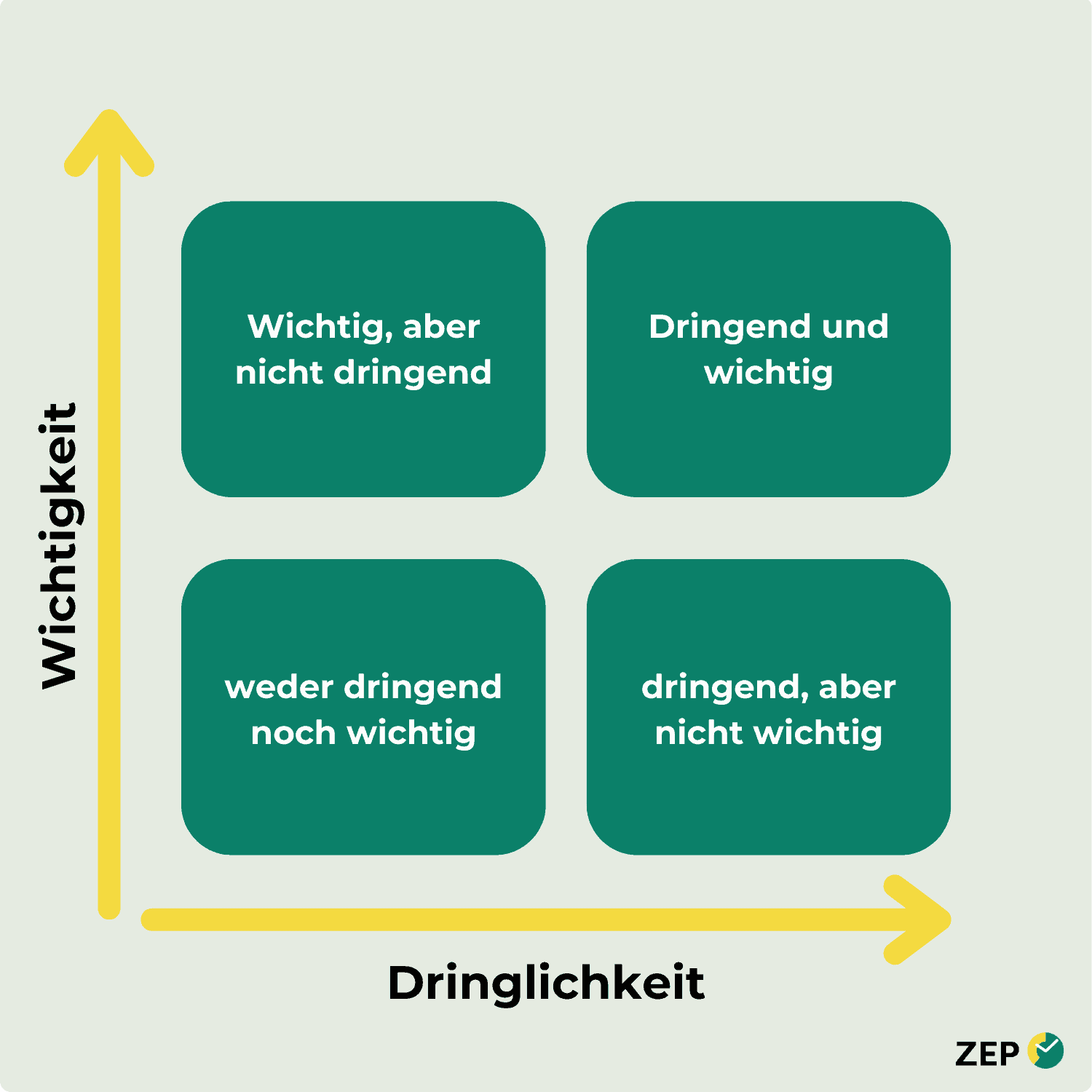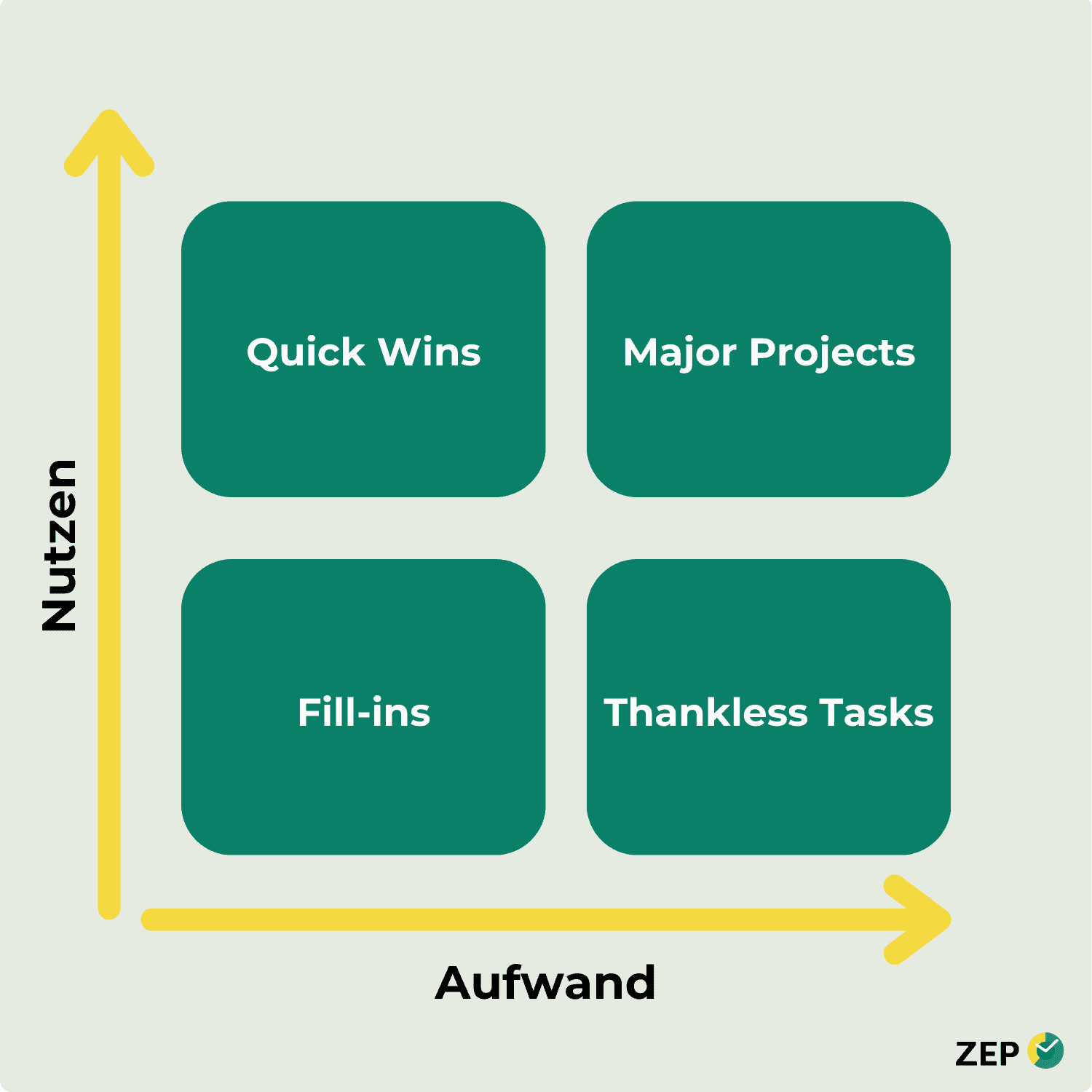
Was ist wichtig und was nicht? Wofür verwenden Sie Ihre Zeit und Aufmerksamkeit und was bleibt vorerst unerledigt? Prioritäten setzen ist ein wesentlicher Schritt, um produktiv und effektiv zu arbeiten. Warum? Wer nicht priorisiert, läuft Gefahr:
• von der Vielzahl an Aufgaben überfordert zu sein,
• nicht voran zu kommen, obwohl viel gearbeitet wird,
• in Stress zu geraten und
• den Überblick zu verlieren oder develop burnout symptoms.
Kurzum: Ohne die Fähigkeit Prioritäten zu setzen sind Sie in vielen Bereichen des Arbeitslebens dazu verurteilt, zu scheitern oder zumindest einer vermeidbaren Überlastung ausgesetzt zu sein. Konsequentes Priorisieren unterstützt Sie dabei, Ihre Zeit und Energie auf die wirklich wichtigen Dinge zu fokussieren.
Die Festlegung von Prioritäten dient als effektive Strategie zur Vermeidung von Prokrastination. Indem Sie Ihre Aufgaben gezielt nach ihrer Wichtigkeit sortieren, gewinnen Sie Klarheit über die nächsten Arbeitsschritte. Durch die Konzentration auf wesentliche Aufgaben verhindern Sie Ablenkung durch Nebentätigkeiten. Ein solcher klarer Fokus erleichtert Ihnen den schnellen Einstieg in Ihre Arbeit und reduziert die Neigung zur Vermeidung.
Die Fähigkeit, Prioritäten zu setzen, ist ein entscheidender Faktor für Erfolg und Glück, sowohl im beruflichen als auch im privaten Leben. Mangelnde Prioritäten führen oft zu Verzettelung, Überschreiten von Deadlines, zu fehlerhaften Entscheidungen und artet letztlich nur in Stress aus. Sehen Sie das Setzen von Prioritäten nicht nur als organisatorische Maßnahme, sondern als unabdingbare Notwendigkeit. Aufgrund begrenzter Ressourcen wie Zeit, Geld und Arbeitskraft müssen Sie täglich Entscheidungen treffen, wie Sie diese Ressourcen bestmöglich einsetzen.
Wenn Sie sich fragen, wo schon wieder die ganze Zeit geblieben ist, sollten Sie anfangen, Prioritäten zu setzen. Aber wie gehen Sie das genau an? Wir stellen Ihnen fünf bewährte Methoden vor, mit denen es Ihnen leichter fällt, Ihre Aufgaben hierarchisch zu ordnen:

Termine, Besprechungen, Protokolle – die Liste Ihrer Aufgaben ist lang, aber die Zeit ist knapp! Wenn Sie sich in dieser Situation wiedererkennen, wissen Sie manchmal nicht mehr, wo Ihnen der Kopf steht. Welche Aufgabe sollten Sie zuerst angehen? Das Telefonat mit dem Kunden? Oder wäre es besser, zuerst die E-Mail von Herrn Dringlich zu beantworten? Was ist überhaupt wichtig?
Prioritäten zu setzen gestaltet sich oft schwierig, besonders wenn Sie unter Zeitdruck stehen. In solchen Situationen kann Ihnen the Eisenhower matrix – benannt nach dem ehemaligen US- Präsidenten Dwight D. Eisenhower – weiterhelfen. Mit dieser Methode unterteilen Sie Aufgaben in vier Kategorien:
1. important and urgent
2. important, but not urgent
3. urgent, but not important
4. neither important nor urgent
Durch die Zuordnung Ihrer Aufgaben zu diesen Kategorien können Sie entscheiden, welche zuerst erledigt werden sollen, welche Sie delegieren können oder welche To-dos Sie komplett streichen können. So erhalten Sie einen klaren Fokus über Ihren Projektablauf, sodass Sie nicht von unwichtigen Aufgaben abgelenkt werden.

Sie werden immer Projektziele haben, die als äußerst wichtig betrachtet werden. Doch müssen alle Ziele zwingend als solche gelten? Vermutlich nicht! Im Projektverlauf können sich Situationen ergeben, in denen Sie Entscheidungen treffen müssen, die ggf. die Projektziele beeinflussen. Um diese sinnvoll zu priorisieren, bietet sich the MoSCoW method to.
- Must have (mandatory requirements): Aufgaben, die zwingend erfüllt werden müssen. Diese sind entscheidend für den Projekterfolg und nicht verhandelbar. Fehlt die Erfüllung dieser Anforderungen, gilt das Projekt als gescheitert. Beispiel: In einem Softwareentwicklungsprojekt muss die Anwendung über eine sichere Authentifizierungsfunktion verfügen. Ohne diese Grundanforderung ist das gesamte Projekt gefährdet.
- Should have (target requirements): Wichtige Aufgaben mit hoher Priorität, die wann immer möglich abgeschlossen werden sollten. Ihr Nichterfüllen kann den Projekterfolg beeinträchtigen, jedoch können sie im schlimmsten Fall in ein Folgeprojekt verschoben werden. Muss-Anforderungen haben stets Vorrang. Beispiel: Bei der Implementierung eines Customer Relationship Management (CRM) Systems sollte die Integration mit vorhandenen Unternehmensanwendungen prioritär behandelt werden. Der Erfolg des Projekts wird beeinträchtigt, wenn diese wichtige Aufgabe vernachlässigt wird.
- Could have (optional requirements): Erfüllung wird angestrebt, aber der Projekterfolg wird nicht an ihnen gemessen. Oft als „nice to have“ bezeichnet, können sie bei Zeit- oder Ressourcenkonflikten vernachlässigt oder verschoben werden. Dennoch sollten sie näher betrachtet werden, wenn sie ohne großen Aufwand umgesetzt werden können, da sie oft einen großen Unterschied in der Zufriedenheit der Stakeholder machen. Beispiel: Für ein Marketingprojekt könnte die Integration von Social-Media-Funktionen in die Kampagnen-Plattform wünschenswert sein. Obwohl dies nicht entscheidend ist, könnte es die Stakeholder-Zufriedenheit erheblich steigern.
- Won’t have (Wird nicht umgesetzt): Diese Anforderungen werden klar definiert und sollen nicht im Rahmen des Projekts umgesetzt werden. Dies dient dazu, zu klären, was (noch) nicht angestrebt wird, aber für zukünftige Zusammenarbeit wichtig sein könnte. Beispiel: Bei der Entwicklung einer Unternehmenswebsite wird entschieden, dass die Einbindung von Online-Spielen (zumindest vorerst) nicht umgesetzt wird, da dies nicht den Hauptzielen des Projekts entspricht.
Die Bezeichnung „MoSCoW“ entstand ursprünglich als „MSCW“. Um die Aussprache zu erleichtern, wurden die „o“s eingefügt und bewusst klein geschrieben, da sie keine inhaltliche Bedeutung haben.
Also the Pareto principle unterstützt Sie dabei, wichtige von weniger wichtigen Aufgaben zu unterscheiden. Diese Methode, auch als 80/20-Regel bekannt, formuliert eine grundlegende Aussage, die Sie auf zahlreiche Kontexte anwenden können:
With 20 % of effort, 80 % of effect is already achieved.
Mit anderen Worten: Es besteht ein erhebliches lineares Ungleichgewicht zwischen Aufwand und Ergebnis. Stellen Sie sich in der praktischen Anwendung stets die Frage: Wie ist das Verhältnis zwischen dem investierten Aufwand und dem erzielten Nutzen? Bei jeder Aufgabe sollten Sie abwägen, wie dieses Verhältnis aussieht und auf dieser Grundlage dann entscheiden, ob die Aufgabe wirklich sofort erledigt werden sollte, wie gründlich Sie diese erledigen und ob Sie die Aufgabe überhaupt erledigen sollten. Die Zahlen 20 und 80 Prozent dienen hierbei lediglich als grobe Richtlinie. Wichtig ist nur, dass Sie beim Prioritäten setzen Ihre Aufgaben in „hoher Aufwand“ und „geringer Nutzen“ kategorisieren.
The basic principle of the Action priority matrix sollte Ihnen mittlerweile bereits vertraut sein. Denn ähnlich wie beim Pareto-Prinzip stellen Sie sich zwei entscheidende Fragen:
EffortWhat effort does this task require?
ImpactWhat benefit or effect do I achieve with this task?
The evaluation of the tasks is clearly presented in a matrix and you derive specific recommendations for action based on this:

Quick Wins: „Schnelle Erfolge“ – Hierbei handelt es sich um besonders attraktive Aufgaben, die mit wenig Aufwand einen hohen Effekt erzielen.
Major Projects: „Größere Projekte“ – Diese repräsentieren die anspruchsvolleren Aufgaben im Arbeitsalltag, die selten vernachlässigt werden sollten.
Fill-ins: „Pausenfüller“ – Aufgaben mit geringem Aufwand und geringer Wirkung. Oft müssen diese erledigt werden und eignen sich für Phasen, in denen nicht die volle Energie erforderlich ist.
Thankless-Tasks: „Undankbare Aufgaben“ – Aufgaben mit hohem Aufwand, aber geringer Wirkung sollten sorgfältig hinterfragt werden.
Die Action-Priority-Matrix bietet somit eine strukturierte Methode, um Aufgaben zu bewerten und entsprechend ihrer Priorität zu handeln.
Möchten Sie einen klaren Fokus auf das Wesentliche legen und wirksame Prioritäten setzen? Dann könnte die ABC-Analyse die geeignete Methode für Sie sein. The ABC analysis unterstützt Sie dabei, sich auf das Wesentliche zu konzentrieren. Elemente werden dabei in A-, B- und C-Klassen eingeteilt, um eine Priorisierung vorzunehmen.
Data is classified according to defined criteria such as turnover, consumption or profit. Three main classes are created:
- A-elements: Dies sind die wenigen besonders hochwertigen Elemente mit einem bedeutenden Wertanteil. Die Identifikation dieser Elemente ist entscheidend, da hier der größte Hebel für Erfolg liegt.
- B elements: Diese Elemente bilden das Mittelfeld mit einer mittelmäßig hohen Anzahl und einem mittelmäßigen Wert. Je nach Situation kann es sinnvoll sein, diese genauer zu betrachten oder vorerst zu vernachlässigen.
- C-elements: Dies sind die vielen Elemente, die zwar in großer Zahl auftreten, jedoch nur einen vergleichsweise geringen Einfluss auf das Gesamtbild haben. Eine intensive Fokussierung auf diese Elemente hat nur begrenzte Auswirkungen und kann oft viel Zeit in Anspruch nehmen.
Die ABC-Analyse findet Anwendung in verschiedenen Unternehmensbereichen wie Logistik, Einkauf, Kundenanalyse, Zeitmanagement und selbstverständlich im Projektmanagement.
Auch wenn Sie es geschafft haben, dank der bewährten Methoden, Ihre Prioritäten sinnvoll zu setzen, gibt es immer auch ein paar Fallstricke, über die Sie stolpern könnten. Dies sind die häufigsten Fehler beim Prioritäten setzen:
1. Prioritäten bekommen keine Zeit:
Prioritäten sollen Ordnung schaffen, die Organisation erleichtern und Zeit, Energie sowie Stress sparen. Es ist entscheidend, ausreichend Zeit zu investieren, um die richtigen Prioritäten zu setzen. Die Prioritätensetzung selbst sollte als oberste Priorität betrachtet werden. Ignoriert man diesen Umstand, erhalten falsche Aufgaben Vorrang, noch bevor die Rangfolge feststeht. Die Arbeit beginnt im Blindflug.
2. goals are lost sight of:
Das Setzen von Prioritäten ist an sich nicht schwer: Man entscheidet, welche Aufgaben zuerst erledigt werden und arbeitet die Liste Punkt für Punkt ab. Doch dann new tasks are added, und der Überblick über Projekte und offene Baustellen geht verloren. Es ist daher von großer Bedeutung, das große Ganze im Auge zu behalten. Mit einer langfristigen Perspektive können die vielen kleinen Aufgaben besser organisiert und wie ein Puzzle zusammengesetzt werden.
3. Prioritäten werden nicht eingehalten:
Selbst die besten Prioritäten sind wirkungslos, wenn sie nicht beachtet werden. Menschen neigen dazu, sich selbst zu täuschen. Ständige Ablenkungen durch Telefonate, laute E-Mails oder Kollegen können dazu führen, dass gute Vorsätze schnell vergessen werden. Es ist wichtig, sich daran zu erinnern, dass Prioritäten nicht ohne Grund festgelegt wurden, und sich darauf zu konzentrieren.
4. tasks are not delegated or are delegated incorrectly:
Prioritäten setzen bedeutet nicht nur, die eigenen Aufgaben zu organisieren, sondern auch zu überlegen, ob jemand anders besser geeignet ist, einen Teil zu übernehmen. Dies beschleunigt nicht nur die Ergebnisse, sondern verbessert sie oft auch. Allerdings bedeutet Delegieren nicht, die Aufgabe aus den Augen zu verlieren. Selbst wenn ein Kollege sich um die Aufgabe kümmert, sollte der Fortschritt kontrolliert oder die Aufgabe einem besser geeigneten Kandidaten übertragen werden.
5. new information is ignored:
Prioritäten sind keine festen Gesetze. Es ist erlaubt und sogar ratsam, sie regelmäßig zu hinterfragen, neu zu definieren oder anzupassen. Insbesondere bei neuen Informationen oder Umständen sollten diese berücksichtigt werden, da sie bestehende Prioritäten möglicherweise verschieben. Prioritäten erfordern Flexibilität, um sich an Veränderungen anzupassen.
Die effiziente Festlegung von Prioritäten ist entscheidend, um den Arbeitsalltag zu strukturieren und Stress zu minimieren. Das Aufschieben von zeitnah zu erledigenden Aufgaben, auch bekannt als Prokrastination, ist ein weitverbreitetes Phänomen. Die Ursachen für dieses Verhalten sind vielfältig, und die damit einhergehenden Auswirkungen wie Stress oder ein belastetes Gewissen sind Ihnen wahrscheinlich bekannt. Obwohl es kein universelles Heilmittel gegen Prokrastination gibt, stehen Ihnen zahlreiche Methoden, Tipps und Tricks zur Verfügung, um dieser Tendenz entgegenzuwirken. Mehr zum Thema Prokrastination können Sie hier nachlesen.
In diesem Zusammenhang kann Ihnen unsere Software ZEP dabei helfen, Ihre Zeit effizienter zu nutzen, um Ihre Produktivität zu steigern und Stress zu reduzieren. Unter dem Motto „Work smarter, not harder“ unterstützt ZEP Sie im gesamten Prozess des Projektmanagements – von der dynamic project planning über die Resource allocation until the Accurate recording of all project times. Auf diese Weise können Sie Ihre Prioritäten setzen, Ihre Projektziele verfolgen und verlieren sich nicht in Unwichtigkeiten! Sichern Sie sich hier Ihre kostenfreie und unverbindliche 30-tägige Testversion von ZEP!


Read article ↗

How can you strengthen your employer brand and attract the best talent? Discover 11 effective employer branding measures that will help you stand out from the competition and optimise your recruitment strategy.
Read article ↗
We answer your questions quickly & competently. Contact us by phone or email.
+49 7156 43623-0 or contact form